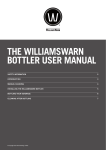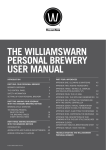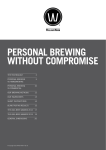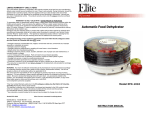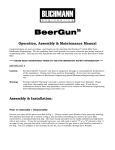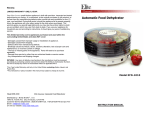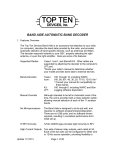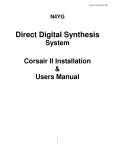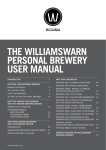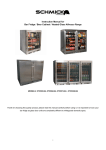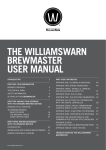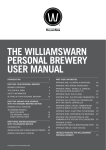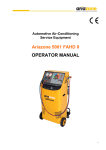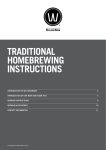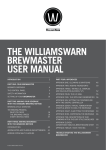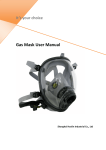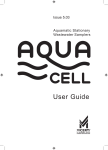Download THE WILLIAMSWARN BOTTLER USER MANUAL
Transcript
THE WILLIAMSWARN BOTTLER USER MANUAL SAFETY INFORMATION 2 BOTTLER COMPONENTS 3 MANUAL CLEANING 4 FREE STANDING BOTTLER ASSEMBLY 5 WALL MOUNTED BOTTLER ASSEMBLY 6 BOTTLING YOUR BEVERAGE FROM A WILLIAMSWARN PERSONAL BREWERY 7 BOTTLING YOUR BEVERAGE FROM A CARBONATED CORNELIUS KEG 9 CLEANING AFTER BOTTLING © Copyright 2013 WilliamsWarn NZ Ltd 11 SAFETY INFORMATION These instructions for use outline general safety guidelines for the correct operation of the WilliamsWarn® Bottler. GENERAL SAFETY 1. It is the responsibility of the operator to read and understand the manual and other (safety) information. Always retain the manual as reference. it doesn’t block a passage; it should be able to stay on the same location for a long period of time. 3. Use WilliamsWarn Bottler at an ambient temperature between 5°C (41°F) and 40ºC (104°F). 2. Never use the WilliamsWarn Bottler for any purpose other than the 'Intended Purpose'. Do not misuse, modify or force the appliance in any way as damage may occur that may create potential hazardous risks or situations. 4. The WilliamsWarn Bottler should only be used with product intended for human consumption. Do not use with hazardous or poisonous substance. 5. If for any reason the WilliamsWarn Bottler malfunctions, please contact [email protected] 3. Don’t use the WilliamsWarn Bottler in uncovered outdoor areas (without a canopy or overhang). 4. Always check if all the components of the WilliamsWarn Bottler are in place before using the device. CLEANING AND MAINTENANCE 1. Always clean following the instructions in this manual and the WilliamsWarn Personal Brewery User Manual. 5. This device is not intended for use by persons (including children) with reduced physical, sensory or mental capabilities, or lack of experience and knowledge, unless they have been given supervision or instruction concerning use of the appliance by a person responsible for their safety. 2. We recommend the use of WilliamsWarn Brewery Detergent and WilliamsWarn Sodium Percarbonate as the detergent and sanitising agents respectively. If other products are used they should be approved brands of dishwashing detergent and approved brands of homebrewing sanitizer that are available commercially for these purposes. 6. Use solely accessories recommended by the supplier. The use of other accessories may result in damage to the WilliamsWarn Bottler, thereby creating hazards for the user. 3. Dispose of the WilliamsWarn Bottler packaging material in the appropriate waste containers. 7. When the WilliamsWarn Bottler is not in use store it in a dry place out of reach of children. 4. When the WilliamsWarn Bottler reaches the end of its useful life it must be disposed of in a responsible manner, thereby ensuring the reuse of parts. INTENDED PURPOSE 1. The intended purpose of the WilliamsWarn Bottler is to bottle cold, clear, perfectly carbonated, professional quality beverage. IMPORTANT The manufacturer isn’t responsible for any damage caused through: COMPONENTS 1. The complete WilliamsWarn Bottler includes main frame with dispense valve and bottle height adjusting screw, support plate, bottle filling tube, bottler base plate with 4 suction feet, allen keys and two support plate screws and 6 wall mounting screws, CO2 and beverage filling lines, black ball-lock fitting for keg out port, grey ball-lock fitting for keg in port, CO2 cylinder low pressure line. 1. Improper handling and use for other purposes than the WilliamsWarn Bottler’s intended purpose. 2. Repairs executed by an unauthorized repairer. 3. The use of non-original components or accessories. For further information or in case of problems not mentioned in this manual you can see our website: www.williamswarn.com or send an e-mail to [email protected] INSTALLATION, STORAGE AND OPERATING CONDITION 1. Assemble the bottler as a portable bottler with suction feet as shown in the assembly section of this manual. 2. Or mount the WilliamsWarn Bottler upright on a vertical, flat and stable surface using the 6 mounting screws. Make sure 2 BOTTLER COMPONENTS The WilliamsWarn® Bottler enables you to bottle your own cold, clear, perfectly carbonated, professional quality beverage in a fast and easy way. This bottler is the ideal addition to a WilliamsWarn® Personal Brewery or as a means to bottle a carbonated beverage from a Cornelius keg. The Bottler can accomodate bottles up to approximately 370mm (14 1/2 inches) in height, allowing a variety of bottle types to be used. The Bottler will allow you to pressurize the bottle with CO2 before filling it up, making sure your beverage doesn’t lose its freshness and carbonation when transferred to the bottle. The parts of the Bottler are shown in Figure 1. Fig. 1 9 5 6 7 1 2 8 3 4 1. MAIN FRAME WITH DISPENSE VALVE AND 5. ALLEN KEYS AND TWO SUPPORT PLATE BOTTLE HEIGHT ADJUSTING SCREW SCREWS AND 6 WALL MOUNTING SCREWS 2. SUPPORT PLATE 6.CO2 AND BEVERAGE FILLING LINES 3. BOTTLE FILLING TUBE 7. BLACK BALL-LOCK FITTING FOR KEG OUT PORT 4. BOTTLER BASE PLATE WITH 4 SUCTION FEET 8. GREY BALL-LOCK FITTING FOR KEG IN PORT 3 9. CO2 CYLINDER LOW PRESSURE LINE MANUAL CLEANING Before you install the WilliamsWarn® Bottler, the dispense valve needs to be thoroughly cleaned. This removes any leftover residues from manufacturing. CLEANING PROCEDURE 1. Remove the black dispense valve from the main frame by removing the holding rubber and by sliding the valve out of the frame. Fig. 2 2. Remove the black beer and CO2 knobs as shown in Figure 2. Remove the smaller black Variable Pressure Relief Valve (VPRV) so that all three knobs are removed as shown in Figure 3. 3. Fill a bowl or jug with 1 litre of warm water and add 1 teaspoon of WilliamsWarn Brewery Detergent or any common dishwasher detergent. Place all components in the soapy water and let them soak for a minute or two. 4. Rinse all components with water. 5. Dry all components and re-assemble the valve. Fig. 3 4 FREE STANDING BOTTLER ASSEMBLY 1. Use the 2 provided support plate screws to attach the top part of the support plate to the main frame as shown in Figure 4. Fig. 4 Fig. 5 Fig. 6 Fig. 7 2. Attach the base plate and 4 suction feet to the main frame and support plate as shown in Figure 5. The bottler frame is now set up. 3. Position the bottler next to your brewery or keg as shown in Figure 6 or over a sink as shown in figure 7 (in which case you will need to move the brewery/keg close to the sink). In Figure 6, the bucket is used to collect any drips of beverage that drop off the filling tube when you remove each bottle. 5 WALL MOUNTED BOTTLER ASSEMBLY You can permanently mount the bottler to a wall as shown in Figure 8. Use the 6 screws provided to secure it to the wall. Fig. 8 6 BOTTLING YOUR BEVERAGE FROM A WILLIAMSWARN PERSONAL BREWERY You can see a video of this process at the "Our User Manuals" page on the WilliamsWarn website, www.williamswarn.com/our-user-manuals 1. Push the CO2 line (black line) into the fitting as shown in Figure 9 (the fitting on the same side as the VPRV). Push the line down hard and then pull back gently to ensure it is locked into place. Fig. 9 Fig. 10 Fig. 11 Fig. 12 Fig. 13 Fig. 14 2. Push the Beverage line (clear line) into the fitting on the other side as shown in Figure 10. Again, push the line down hard and then pull back gently to ensure it is locked into place. 3. Connect the Beverage line (clear line) into the brewery filling line valve at the back of the Draft Tap Font as shown in Figure 11. 4. In the same manner connect the CO2 line (black line) into the CO2 line valve coming from the back of the Draft Tap as shown in Figure. 12. 5. Set the WilliamsWarn Bottler to the right size for the type of bottle you want to fill. The minimum size of the bottle is 20cm (±8 inches) and the maximum size is 37cm (±14.5 inches). 6. Insert the filler tube as shown in Figure 13. If the tube length does not match the height of the bottle you are using, you need to cut the tubing to match. The tubing should sit at the bottom of the bottle once the bottle is attached. 7. Place a bottle in the bottler as shown in Figure 14. Press on the screw to depress the spring to lower the bottle base holder to easily put a bottle on or take it off. You will need to screw the bottle height adjusting screw to get a good seal around the top of the bottle. 8. Screw all three black knobs on the filling valve to close them fully, as shown in Figure 15. The CO2 knob and the VPRV knob screw in clockwise and the beverage line knob screws in anti-clockwise. Therefore when you are looking front-on to the bottling head, rolling the front of the knobs up closes them and rolling the fronts down opens them to the bottle. 9. Open the brewery filling line valve at the back of the Draft Tap Font. Make sure the brewery is pressurized (e.g. 1-1.5 bar) and that the brewery 3-way valve is onto the brewery vessel so that the brewery is under the same pressure during the bottling process as the bottler. In this way the brewery and bottler are both connected to the same gas bottle in the tower. See Figure 16. 7 10.Open the CO2 line valve at the back of the Draft Tap Font. See Figure 17. Fig. 15 11.Open the black CO2 knob as shown in Figure. 18 (anti-clockwise). You will hear CO2 pressurize the bottle. 12.Open the VPRV (anti-clockwise) as shown in Figure 19, until you hear the CO2 escape out of the VPRV. This removes air from the base area inside the bottle to reduce oxidation of the beverage. 13.Close the black CO2 knob as shown in Figure 20 (clockwise). 14.Open the black beverage knob (clockwise) as shown in Figure 21 until you see beverage flowing into the bottle. Make sure there is no gas leaking at the seal at the top of the bottle. If there is, then screw the bottle height adjusting screw to tighten the seal better. Fig. 16 Fig. 17 Fig. 18 Fig. 19 Fig. 22 Fig. 23 15.Adjust the VPRV as shown in Figure 19, so that the beverage fills the bottle gently. You can slow the fill speed by turning the VPRV clockwise. You can speed the fill up by turning the VPRV anti-clockwise. For a 500mL bottle (approx. 1 pint), a typical fill speed, to ensure no foaming and no loss of carbonation, would be about 45 seconds. So for a 330mL bottle (approx 12 oz), a 30 second filling time would be about optimal. You may find your own technique and filling time and that is fine. 16.When the bottle is almost full, with about 1/3 of the neck as headspace, close the black beverage knob (anti-clockwise). Leaving some headspace (which is CO2) will prevent spillage when removing the bottle. 17.Press the bottle height adjusting screw to lower the bottler base holder and remove the bottle from the WilliamsWarn Bottler as shown in Figure 22. 18.Then close the bottle lid or cap the bottle as soon as possible to prevent air getting into the bottle as shown in Figure 23. 19.Continue bottling as required by depressing the spring to lower the bottle base holder each time to put on new bottles and take off full bottles. Once the VPRV is set it shouldn't need adjusting as you bottle your batch of beverage. You simply open the CO2 knob for a few seconds to pressurise the bottle (and remove air at the bottle base), close the C02 knob, open the beer knob and then close the beer knob when the bottle is full. Fig. 20 Fig. 21 8 BOTTLING YOUR BEVERAGE FROM A CARBONATED CORNELIUS KEG 1. The principle of bottling from a carbonated keg is the same as for bottling from a WilliamsWarn Personal Brewery. The keg and the bottler need to share the same CO2 cylinder so that they are under the same pressure when the bottle is pressurized. Then when the VPRV releases pressure from the bottle, beer flow can occur into the bottle. Fig. 25 Fig. 26 Fig. 27 Fig. 28 Fig. 29 Fig. 30 The set-up will look like that in Figure 24. In order to do that, follow these instructions. 2. If the low pressure fitting on your regulator does not take the black ¼ inch external diameter low pressure line provided, you will need to use the plastic fitting provided and screw it into your regulator as shown in Figure 25. It is recommended to use thread tape on the thread to get a good seal (not provided). 3. Connect the grey ball-lock fitting and t-piece to the end of the low pressure line as shown in Figure 26. 4. Connect the black CO2 line to the t-piece as shown in Figure 27. 5. Connect the black ball-lock fitting to the clear beverage filling line as shown in Figure 28. 6. Connect the black CO2 line to the CO2 port on the bottler as shown in Figure 29. 7. Connect the clear beverage line to the beverage port on the bottler as shown as shown in Fig 30. Fig. 24 9 8. Close the VPRV, the gas knob (both clockwise) and the beverage knob (anti-clockwise) on the bottle dispense valve. As shown in Figure 31. Fig. 31 9. Attach the bottle filling tube by pushing it hard up the cone under the bottler valve. As shown in Figure 32. 10.Open your gas regulator to the pressure that you have the keg carbonated to. If you are not sure what pressure that is, it is better to be on the high side i.e. put more pressure on the keg during bottling than you estimate was used to carbonate the keg. This is to ensure carbonation stays in the beverage during the filling of the bottle. As shown in Figure 33. 11.Attach the grey ball-lock fitting to the IN port on the Cornelius keg. As shown in Figure 34. 12.Attach the black ball-lock fitting to the OUT port on the Cornelius keg. As shown in Figure 35. Fig. 32 Fig. 33 Fig. 34 Fig. 35 Then turn to the previous section in this manual titled “Bottling your beverage from a WilliamsWarn Personal Brewery” and follow the bottling instructions from Step 11 onwards to the final step. 10 CLEANING AFTER BOTTLING If you empty your WilliamsWarn brewery by bottling the contents, you can clean the bottler as part of the brewery clean. However it is optimal to first close the two valves on the back of the draft tap font and dismantle the bottler dispense valve as described in the section "Manual Cleaning" in this user manual. Then give the components a good rinse under running water. Then reassemble the valve and reconnect the beverage and CO2 lines to the bottler valve and the brewery valves on the draft tap font ready for the cleaning in Stage 1, as described in the Personal Brewery User Manual. Fig. 36 If you have bottled from a keg, the principle is to add detergent to the keg as you do to clean it, and then allow flow of the detergent out of the keg and through the beverage filling line, bottle dispense valve and bottle filling tube by pressurizing the keg and opening the bottle filling knob at the bottler. If you have only filled a few bottles and the brewery or keg still contains beverage and therefore cannot be cleaned, then the bottler should be cleaned separately. Cheers! In this case, close the brewery filling line valve and CO2 line valve at the back of the brewery or disconnect the ball-lock fittings from the keg, then disconnect the CO2 and beverage tubing from both the brewery or keg fittings and the bottler. You need to push the connecting rings downward on the fittings whilst simultaneously pulling the tubing out. Next, follow the cleaning procedures outlined in the "Manual Cleaning" section at the front of this manual. In addition to what is described you will need to clean the CO2 and beverage tubing with detergent and rinse them as well with water. This can be done by filling the lines and soaking them in detergent for 5 minutes then flushing them. It is then recommended to sterilize the components with a no-rinse sterilant such as WilliamsWarn Sodium Percarbonate. Drain the components and then reassemble the bottler as per the instructions. To clean your bottles, after emptying a bottle, rinse the bottle with water, drain and store until you have enough bottles to go in your dishwasher. If you use swing top bottles, put the lid on to protect the bottles from insects and dust. When ready, put the bottles in a dishwasher as shown in Figure 36 (with the lids off). Give the bottles a wash on a full normal cycle but with no detergent added. The water is usually about 65°C / 149°F in a typical dishwash and this is enough to pasteurize the bottles. In addition, the steam and moisture generated in the dishwasher is enough to circulate into the bottles which gives them a good clean. Ian Williams 11 Anders Warn











